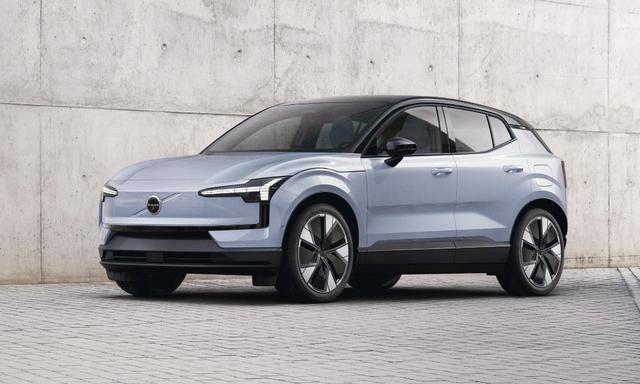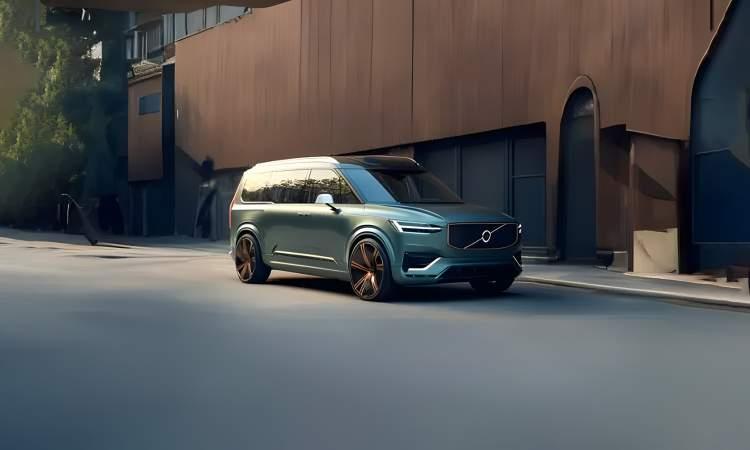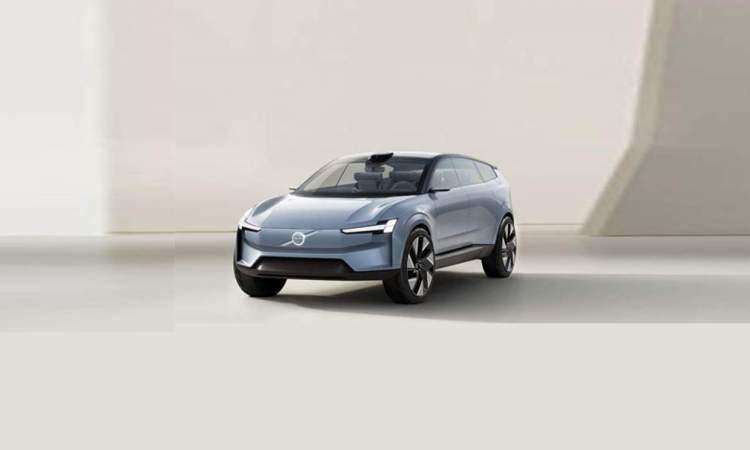
वॉल्वो ईएएक्स 30 रिचार्ज
वॉल्वो ईएएक्स 30 रिचार्ज Images

वॉल्वो ईएएक्स 30 रिचार्ज ओवरव्यू
फ्यूल टाइप | Electric |
ट्रांसमिशन | Automatic |
बैटरी की रेंज | 480 किलोमीटर/फुल चार्ज |
समय चार्ज | 3 Hrs |
बैठने की | 5 सीटर |
एयरबैग | 8 |
Base Variant |
वॉल्वो ईएएक्स 30 रिचार्ज स्पेसिफिकेशन & फीचर्स
वॉल्वो ईएएक्स 30 रिचार्ज वेरिएंट
वेरिएंट
एक्स-शोरूम कीमत
ईएएक्स 30 रिचार्ज STD
शुरू
₹ 39.99 लाख
Electric, 480 KM/L, Automatic
वॉल्वो ईएएक्स 30 रिचार्ज ईएमआई कैलक्यूलेटर
एक्स-शोरूम कीमत
₹ 39.99 L
उधार की राशि
39.99 L
अवधि (5 साल)
5 साल
ईएमआई ₹ 83,012
के लिए 5 वर्ष @9%* ब्याज दर
*ब्याज दर आपके क्रेडिट स्कोर के आधार पर भिन्न हो सकती है।
वॉल्वो ईएएक्स 30 रिचार्ज माइलेज
480.00
Km/Full Charge
97 %
की ईंधन दक्षता कितनी है वॉल्वो ईएएक्स 30 रिचार्ज
वॉल्वो ईएएक्स 30 रिचार्ज mileage is 480 Km/Full Charge as per ARAI The Automatic Electric engine has a mileage of 480 Km/Full Charge.
ईंधन के प्रकार से माइलेज
| फ्यूल टाइप | ||
|---|---|---|
| ट्रांसमिशन | ||
| माइलेज | ||
| Electric | Automatic | 480 Km/Full Charge |
वॉल्वो ईएएक्स 30 रिचार्ज यूजर रिव्यु
रेट करने के लिए टैप करें :
Be The First One To Review This Car
Share your experience about वॉल्वो ईएएक्स 30 रिचार्ज
तुलना करें प्रतियोगी के साथ
 वॉल्वो ईएएक्स 30 रिचार्ज |  |  |  |  |  |
| एक्स-शोरूम प्राइस | |||||
| ₹ 39.99 लाख | ₹ 28.99 - 39.43 लाख | ₹ 24.93 - 35.07 लाख | ₹ 24.23 - 29.57 लाख | ₹ 56.72 लाख | ₹ 57.88 लाख |
| सी एंड बी विशेषज्ञ रेटिंग | |||||
| N/A | 8.1 | N/A | N/A | N/A | N/A |
| इंजन | |||||
| N/A | N/A | N/A | N/A | N/A | N/A |
| ट्रांसमिशन | |||||
| ऑटोमेटिक | आटोमेटिक | आटोमेटिक | आटोमेटिक | आटोमेटिक | आटोमेटिक |
| माइलेज | |||||
| 480 किलोमीटर/फुल चार्ज | 468 - 521 KM/L | 627 KM/L | 438 - 532 KM/L | 567 KM/L | 440 KM/L |
| फ्यूल टाइप | |||||
| इलेक्ट्रिक | इलेक्ट्रिक | इलेक्ट्रिक | इलेक्ट्रिक | इलेक्ट्रिक | इलेक्ट्रिक |
| सीटिंग कपैसिटी | |||||
| 5 Seater | 5 सीटर | 5 सीटर | 5 सीटर | 5 सीटर | 5 सीटर |
| फ्यूल टैंक कपैसिटी | |||||
| N/A | N/A | N/A | N/A | N/A | N/A |
| वेरिएंट की संख्या | |||||
| 1 | 3 | 16 | 5 | 1 | 1 |
विस्तृत तुलना | ईएएक्स 30 रिचार्ज vs एटो 3 ईवी | ईएएक्स 30 रिचार्ज vs हैरियर ईवी | ईएएक्स 30 रिचार्ज vs वीएफ7 | ईएएक्स 30 रिचार्ज vs सीलायन 7 | ईएएक्स 30 रिचार्ज vs आईईएक्स1 L |
वॉल्वो ईएएक्स 30 रिचार्ज न्यूज़

नई वॉल्वो EX30 इलेक्ट्रिक एसयूवी भारत में हुई लॉन्च, कीमत रु.39.99 लाख 

3 महीने पहले
1 मिनट पढ़े

वॉल्वो EX30 इलेक्ट्रिक एसयूवी लॉन्च से पहले भारत में टैस्टिंग के दौरान दिखी

5 महीने पहले
3 मिनट पढ़े

वॉल्वो EX30 क्रॉस कंट्री से उठा पर्दा; बेहतर ग्राउंड क्लीयरेंस के साथ मिले ऑल-टेरेन टायर

10 महीने पहले
1 मिनट पढ़े

वॉल्वो EX30 को यूरो एनकैप क्रैश टैस्ट में मिली पूरी 5 स्टार की सुरक्षा रेटिंग

1 वर्ष पहले'
1 मिनट पढ़े

वॉल्वो ने भारत में EX30 EV के लॉन्च पर लगाई मुहर, 2025 में बिक्री के लिए होगी उपलब्ध 

1 वर्ष पहले'
1 मिनट पढ़े
वॉल्वो ईएएक्स 30 रिचार्ज अल्टरनेटिव
आने वाली वॉल्वो कारें
अप्कमिंग वॉल्वो कार वॉल्वो ईएम 90एक्सपेक्टेड प्राइस₹ 60 - 80 Lएक्सपेक्टेड लॉन्चफ़र॰ 26, 2026
वॉल्वो ईएम 90एक्सपेक्टेड प्राइस₹ 60 - 80 Lएक्सपेक्टेड लॉन्चफ़र॰ 26, 2026 वॉल्वो एक्ससी70एक्सपेक्टेड प्राइस₹ 50 - 60 Lएक्सपेक्टेड लॉन्चजून 26, 2026
वॉल्वो एक्ससी70एक्सपेक्टेड प्राइस₹ 50 - 60 Lएक्सपेक्टेड लॉन्चजून 26, 2026 वॉल्वो ES90 इलेक्ट्रिकएक्सपेक्टेड प्राइस₹ 1 - 1.1 Crएक्सपेक्टेड लॉन्चजुल॰ 5, 2026
वॉल्वो ES90 इलेक्ट्रिकएक्सपेक्टेड प्राइस₹ 1 - 1.1 Crएक्सपेक्टेड लॉन्चजुल॰ 5, 2026 वॉल्वो ईए एक्स रिचार्जएक्सपेक्टेड प्राइस₹ 95 L - 1 Crएक्सपेक्टेड लॉन्चसित॰ 30, 2026
वॉल्वो ईए एक्स रिचार्जएक्सपेक्टेड प्राइस₹ 95 L - 1 Crएक्सपेक्टेड लॉन्चसित॰ 30, 2026
वॉल्वो ईएएक्स 30 रिचार्ज अल्टरनेटिव
वॉल्वो डीलर & शोरूम
- पत्रिका
- नई कारें
- वॉल्वो कारें
- वॉल्वो ईएएक्स 30 रिचार्ज









